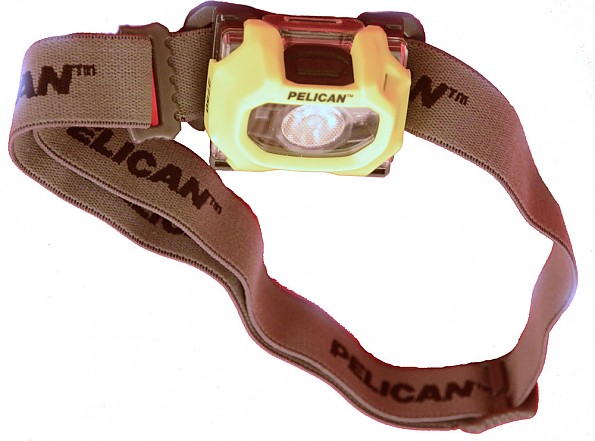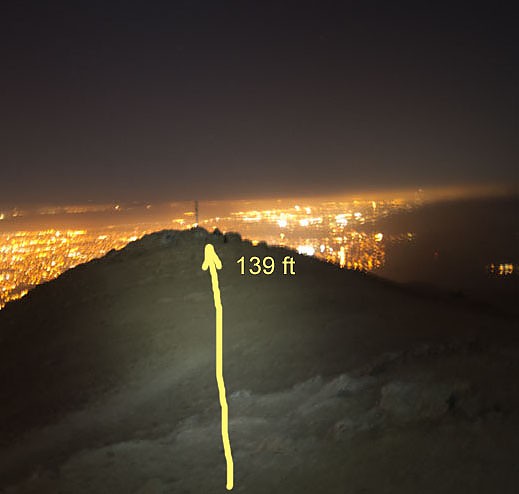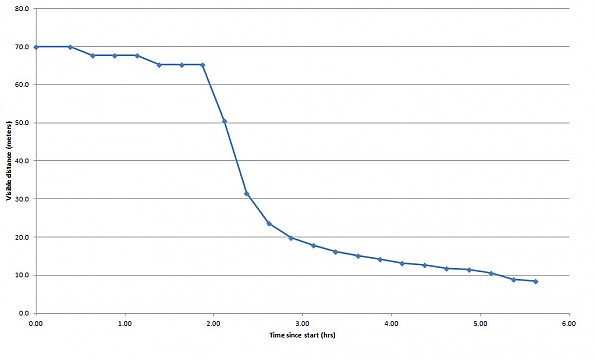Pelican 2750 LED Headlamp
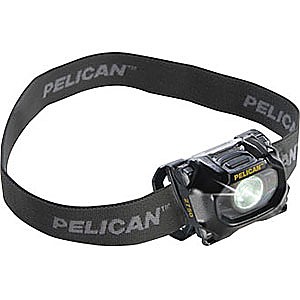
The Pelican 2750 is a high tech headlamp featuring two brightness levels (40 and 100 lumens) plus a red (night vision) LED. Pelican has long been known for its extremely rugged photographic and scientific instrument cases (lifetime warranty against any damage “except by a 3-year old child”) and to a lesser extent for their lighting products and underwater gear. The 2750 is one of a family of headlamps, and is well-suited for use in backpacking, night hiking, and pre-dawn approaches to climbing routes.
Pros
- Bright focused 2-level LED and red LED, plus emergency strobe settings of the white and red LEDs
- Low power setting is bright enough nd has a good beam spread for most use by hikers and backpackers, as well as most approaches from high camp to the serious climbing, giving 12 hours battery life with 3 AAA batteries
- On highest setting of the white LED, excellent for route-finding for pre-dawn approaches or those late night descents back to the trailhead, as well as night-time skiing, bicycling and night-time running events
- Low power setting is excellent for map-reading or for reading when tent-bound or bivouacking
- Lithium and Alkaline non-rechargeable AAA, and rechargeable Lithium, NiMH, and NiCd AAA batteries can be used.
- Yellow color makes the headlamp easier to find inside a black pack
- Water resistant to IPX4 standard (moderate to heavy rain, but not immersion)
- Low battery is indicated by blinking indicator light (light is still bright enough for trail navigation for another 2 or 3 hours).
Cons
- At full brightness on busy trails, oncoming hikers will be blinded temporarily, prompting loud complaints.
- On the high power setting (100 lumens), battery life with Ultimate Lithiums is only 3h45m, not enough for a lengthy technical approach and return.
- Only two light levels plus the single red “night vision” LED, which is almost too dim for my presbyopic eyes.
- Does not have a lockout for the power button, so it could be turned on accidentally if jammed down in a pack (button is recessed to reduce accidental “on” possibility).
- Not carried in the usual outdoor stores, but can be found in “Big Box” outdoor stores and online.
Weight: 2-3/8 oz/82 grams
Suggested Retail Price: $35.95
Warranty: Pelican "Lifetime" warranty
Background:
A significant part of the general discussion of headlamps and my testing methods overlap with my recent reviews of the Petzl NAO and Black Diamond Icon Polar. The headlamp specifics differ, of course, since the Icon Polar and NAO represent very different philosophies and approaches to the outdoor performance lighting problem.
As described in those reviews, I have used everything from candle lanterns, kerosene lanterns, and carbide headlamps through various battery-powered miners’ headlamps to the current lightweight LED headlamps for backpacking, making approaches to climbs, and skiing, as well as commuting by bicycle over the years.
Over the past 10 years or so, headlamp technology has made huge leaps forward in dependability, and light weight (thanks to the brightness and efficiency of LEDs and improvements in batteries, both standard lithiums and rechargeable lithiums and NiMH). 
For many outdoor activities, whether on the trail or in camp, having a light source that is dependable is vital. I heavily use lights for approaches, returning to the trailhead or camp after a long day, reading the map or climbing topo during the climb, or a book while holed up in the tent. There are several requirements I have for a lamp:
- The batteries must last long enough to provide light during pre-dawn approaches, post-sunset returns to camp, and setting up bivouacs, including any delays.
- It has to provide an appropriate level of light during the various stages of the trip.
- It has to be light enough weight to be comfortable to wear, or for a tent light, have a convenient way to hang it.
- For map reading, the color of the light has to render all the map colors clearly (I have had the experience of a light with a yellowish or reddish tint making yellow or red markings almost invisible or in some cases producing a color shift that masked details).
- It has to be durable enough to survive the rough handling that inevitably happens during an expedition.
- It has to be easily found in the pack (none of those tiny black LED lights that hide inside a black pack!)
- For my winter, high altitude, and polar trips, it has to perform at low temperatures.
- The final question is “Do I really need a headlamp this bright, this automated, and this expensive?”
Details of Operation:
I have had a number of Pelican products over the years, mostly their camera cases and small waterproof boxes, but also including several of their flashlights and a headlamp intended for bicycling (it has a flashing red light on the back of the head). The cases have been carried as carryon and checked luggage on airplanes, and have lived up to their reputation. Their lights have also stood up, which indicated to me that the 2750 headlamp should last very well under the bashing that gear typically gets during climbing expeditions.
The packaging was minimal and recyclable, with the headlamp in a shaped plastic “box”, with the specs on the cardboard internal sheet and instruction sheet. The first step, after unpacking the lamp, was to insert a set of 3 AAA batteries, and familiarize myself with the various functions and button pushes.
After playing around with the headlamp a bit, I read the directions, which come in three languages, all of which I can read (good practice for improving fluency). The white LED functions are set by a sequence of button pushes – a single push brings up the full power (rated at 100 lumens), 2 quick pushes produces low power (40 lumens), and 3quick pushes turns on the white-light strobe. The strobe is bright enough for an air search team to see from dusk to dawn, and perhaps in mid-day (I did not test this, but surmise it from my experience with air searches when my wife and I had an airplane).
Shutdown is a single push from any of the settings. The red light modes are reached from the white light modes by holding the power button down for a few seconds (giving the steady red LED on first, then a quick second push turns on the red strobe mode). Returning to white light mode is accomplished by holding the power button down for a few seconds.
At the minimum 40 lumen brightness, Pelican rates the battery life at 12 hours, and for the high power setting (100 lumens) gives a rating of 3h 45m. At the 40 lumen minimum, the visibility range is rated at 49 meters, while the full 100 lumen setting is rated to 71 meters. For an explanation of the relation between lumens and lux, see the description later in this review.
There are several precautions that should be observed to ensure long battery and headlamp life. First, when storing the headlamp for an extended period (more than a couple weeks), remove the batteries from the headlamp. Most modern batteries from reputable companies will not leak in storage. Such leakage can result in corrosion of the contacts and possibly permanent damage to the headlamp. I recently discovered that a Black Diamond headlamp that I have had for a number of years had this happen, because I neglected to remove the batteries when I tossed it in a drawer. It is annoying to have a quality product fail through negligence.
Second, many flashlights and headlamps can be turned on accidentally in a fully packed pack, even when you thought you had positioned it so that would not happen. In recent years, several headlamp manufacturers have redesigned the switches to reduce the likelihood of accidental turn-on. It can still happen, even with the electronic lock-outs.
Third, I have found it is a good idea to carry at least one backup flashlight or headlamp (or at least one of the tiny LED lights). Since LED lamps are polarized, requiring the batteries to be inserted in the correct orientation, having the backup lamp when the main lamp’s batteries run out in the darkest of nights (or caves), is a tremendous help when installing fresh batteries. If this has not happened to you yet, rest assured that it will happen, and in the darkest location possible.
Details of Testing:
My first few operational tests involved just walking around the block and to the local pizza and ice cream shops. I discovered that, at the high power setting, I could easily see our California reflectorized license plates and stop signs up to a block away. Our area has standardized 1/8 mile blocks, so I was spotting the reflectors well over 100 meters away.
Of course, this is not like seeing details that far away in the dark woods or on a mountain trail, since stop signs and reflectorized license plates are intended to be seen at long distances. But this will prove handy in finding the tent when returning after dark, since I have the reflectorized guy lines on all my tents, plus most of my tents have reflectorized tie-down straps.
Just as during my tests of the Petzl and Black Diamond headlamps, I did find that I could spot animal eyes at long distances as well (when you are hiking at night in a Regional Open Space that is known to have mountain lions, and all you can see is a pair of eyes reflecting the headlamp, you really hope that it is a Black Angus cow, and not one of the lions).
I checked the light output and maximum visibility at both settings in several ways. One was the good old eyeball test, in which I went to a very dark location with a 100+ meter clear view (a neighborhood soccer field long after the lights were out). This gave distances of close to 70 meters on high setting and just over 40 meters on low.
Another test was to use a dark room for measuring the light output at one meter from the lamp (the standard distance) using my calibrated Sekonic L-785DR light meter. My measurements of the intensity (in lux, measured at 1 meter) were then scaled to find the distance where the intensity would have been 0.25 lux, the value used by the CEN tests to determine visibility distance. This gave 49 meters at the low setting and 69 meters at the high setting.
I took a number of photos with my Nikon D800, standardized at 1 second, f/3.5, and ISO 1000 for easy comparison of different visibility distances (the D800 replaced the D300s I used during the Petzl and Black Diamond tests). This worked quite well, as can be seen in the Mission Peak summit shots below.
My next tests took me to Mission Peak Regional Open Space Reserve, one of the few Regional Open Space Reserves in my area which permits night hiking. This is the same park I used for the Black Diamond Icon Polar and Petzl NAO reviews. Because of the growing number of hikers in the park who shortcut the switchbacks (both night and day!), the East Bay Regional Parks District has placed a number of fences and signs, which happen to be reflectorized.
These reflectorized signs provide convenient targets for distance measurements, since ground and other non-reflectorized objects do not return enough of my Leica Disto D3 laser distance measuring device’s light for an accurate measurement much over 50 meters (often, dull objects will cause the Leica laser meter to return an error message and no measurement at all). For several of the signs, I moved toward the sign until I can see the ground at the foot of the sign, then used the laser distance measuring device to get the distance of the sign. I would then back away until the ground at the foot of the sign was no longer visible.
For a variety of reasons, I repeated the night hikes on Mission Peak, with a variety of incidents. On one of the hikes, I was delayed in getting to the parking lot by heavy traffic, and so could not go all the way to the summit and get my now-standard summit shot before the official hour to be out of the park. On another, I got to the summit, but did not realize until I got home that I had set the exposure compensation on the camera for a special project, hence had images that were greatly over-exposed.
On yet another occasion, although I had set out from my house under perfectly clear skies, low clouds moved onto the peak, making the upper 500 feet of the hike in a whiteout (good for a demonstration of why NOT to wear a headlamp in fog at night, but to have your lamp shifted well away from your line of sight, just as automobile fog lights are placed well below the driver’s line of vision. At least on the night I forgot the laser distance meter, but I already had noted the lamp, camera, and target positions, giving the photos below.
The lights of the San Francisco Bay provide a background, with San Francisco itself at the right (north) side of the photo and San Jose to the left. The images are pretty much as the eye sees it. 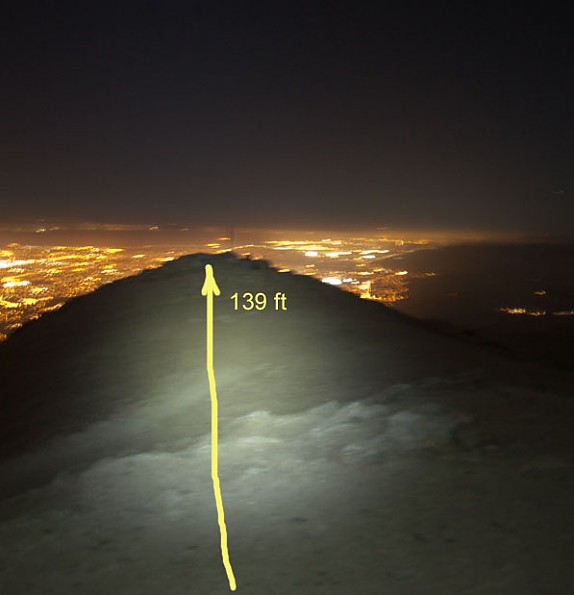
Pelican 2750 on High setting
Pelican 2750 on Low setting
The photo below shows why you should shift any headlamp or other light source well off your line of sight. Even so, the trace of the beam above the rocks (which you can match in the photos above, taken on a clear night) shows how much backscatter you can get and how it blinds you.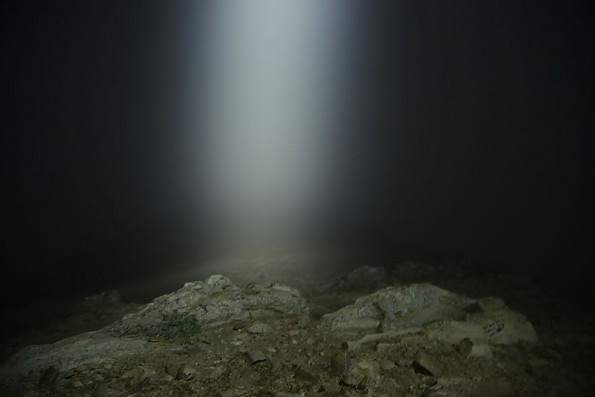
The map below is the GPSR track as I climbed the 3 miles and 2180 ft to the summit, where I took the summit pictures, then returned to the trailhead. 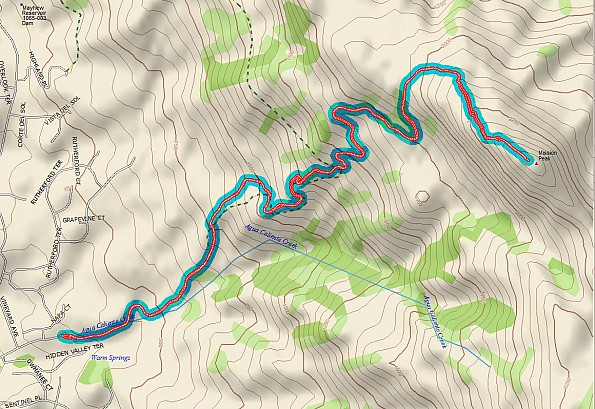
Pelican rates the 2750 at IPX4 for water resistance (splash or rain). This is of significance for many of the intended activities, which are likely to involve heavy rain or snow, as well as wet snow or the foggy, drippy night I hiked to the summit of Mission Peak, not to mention the potential of accidentally dropping it in a stream or lake. As a crude test of water resistance, I dunked the Pelican 2750 in the sink in several inches of water for a couple minutes, then dried the outside and opened the case. There was no water inside the battery compartment, not even drops.
Pelican, like Petzl, Black Diamond and other companies, uses the European standards organization approach (CEN) specify brightness in lumens, while some companies give their specification in lux. If you are not familiar with light measurement, this can be confusing.
To over simplify a bit, lumen is a measure of total light output, while lux is a measure of light “density”. The two are related in that 1 lux is 1 lumen per square meter. Since the intensity (or think of it as the energy density) falls off as the square of the distance, the light falling on a 1 meter square white test card at 10 meters is 4 times as bright as on the same 1 meter square card at 20 meters, measured in lux. The total output in lumens is usually included in the instruction sheet or on the packaging to specify light output of the headlamp.
Pelican, like most manufacturers, also states a visibility distance. Since this is normally determined according to the European standard, this is a reasonable way to get a relative comparison. The CEN (European standards organization) specification uses the distance at which the brightness of a test card illuminated by the headlamp is that produced by the full moon (on a clear night, of course, not like our typical San Francisco area foggy nights). The full moon provides a 0.25 lux illumination. I do find the full moon to be adequate for hiking on most Sierra trails in the open or on glaciers and snow fields.
The lamp color, like most LED headlamps is sufficiently like daylight to render the colors on a USGS or orienteering map recognizable. The red light, intended to preserve night vision, does distort map colors, especially on orienteering maps, where vegetation cover is color coded.
I did a series of battery life tests. Current headlamps with high brightness LEDs go through batteries rapidly, despite the great improvements in efficiency. These tests were performed by mounting the headlamp on a tripod, one meter from the white wall of an otherwise unlit room. The brightness of the lamp was measured at the center of the beam at the 1 meter distance with my Sekonic L-758DR light meter at 15 minute intervals until it faded to non-usability.
Tests were run at both the high power (nominally 100 lumens) and low power (nominally 40 lumens) levels. The batteries used were Energizer Ultimate Lithiums (3000mAH), which perform better at low temperatures than alkaline batteries (2300 mAH), plus have longer useful life than alkalines or rechargeables. I do use Eneloop NiMH rechargeables (2000 mAH) on expeditions where I have a solar panel along for recharging.
The chart below shows the visibility distance calculated from the light meter measurements as a function of continuous burning time for the high power setting. As can be seen, the headlamp stays quite bright for the first 2 hours, then drops over to the next hour to a level quite usable for hiking (including studying the map), preparing dinner after dark, or reading for a bit before going to sleep. The low level setting shows a similar curve, but extended in time with the initial 40 lumen level of brightness lasting for about 6 hours, then gradually dropping until reaching the minimal useful level at about 12 hours.
I also observed the well-known characteristic of lithium batteries that even when largely depleted, leaving the device off for a half hour or so will allow a “rebound” for a short period of time (5 -10 minutes at most). This is not something to depend on, but might help if you suffer a long delay and appear to have depleted your batteries. Keep in mind that lithium, alkaline, NiMH, and NiCd batteries all have different lifetime characteristics, and that rechargeables lose capacity after a few hundred recharging cycles.
Conclusions:
The Pelican 2750 LED headlamp is an excellent choice for a wide variety of outdoor activities, being adequately bright and long enough battery life for pre-dawn approaches and after sundown returns to camp at the low power setting. It may not have the high brightness output of the Black Diamond Icon Polar. But it provides sufficient illumination on 3 AAA batteries.
It appears to be sufficiently rugged for heavy use in active activities like backpacking, mountaineering, rock climbing, and ice climbing, as well as those times when you have to spend time in a bivouac or holed up in a tent of snow cave waiting out a storm. The price is quite reasonable, and the Pelican warranty is one of, if not, the best you will see for any outdoor gear.
Finally, did the Pelican 2750 LED headlamp meet the eight criteria I gave at the start? My personal answer is “yes” to the all eight. While it does not provide the tremendous brightness of the Icon Polar or NAO that an elite climber searching a route on a highly technical wall might need, it provides sufficient light for a long enough time at a price less than half the Icon Polar or 20% that of the NAO with its sophisticated automatic lighting control.
In short, I would recommend that anyone engaged in outdoor activities involving night-time activity at a reasonable price and providing versatility give serious consideration to the Pelican.
Source: received it as a personal gift
Great light, crap band.
Pros
- Bright
- Multi mode
Cons
- Poor band construction
- Not rechargable
This would be my favorite headlamp, but the band started to rip the first day. I have repaired it with a needle and some braided fishing line but would prefer it to be a little more rugged on its own.
Source: bought it new
Price Paid: $20


